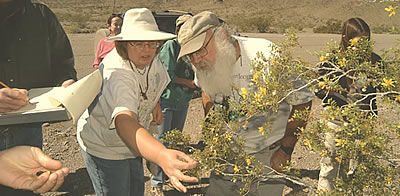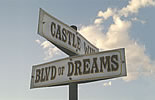| Desert Studies Center Is a NASA Training Ground |
|||||
|
|||||
| Scientists, teachers to use sun-scorched land to learn to look for life on Mars.
March 23, 2007 :: No. 149 NASA scientists and 40 teachers from around the United States—including one from Orange County—will learn how to look for life on the moon and on Mars while walking the sun-scorched earth around the California State University Desert Studies Center at Zzyzx from March 25 through 30. The center has been administered by Cal State Fullerton since it was founded in 1979. Zzyzx is about 60 miles east of Barstow, near Soda Springs. “We have been doing field expeditions to Mars-like environments for years,” said Chris McKay, leader of the team and a planetary scientist with Ames Research Center. Ames, at the Moffett Field location in California, is the base for NASA’s Spaceward Bound project for educating scientists and teachers. “Now we’re bringing along the teachers so they can see and participate in the exploration of these extreme environments. The teachers then become part of the research team.” The team will study the similarities of the desert’s geologic formations to those of the moon and Mars, how microbes and chemical oxidants affect desert soil formation, and the desert’s hypolithic algae (growing beneath rocks in dry areas), cyanobacteria (bacteria that can carry out photosynthesis) and stromatolites (the cementing of grains of rock by microorganisms, including cyanobacteria). “I expect to be able to incorporate some of the science we’ll be doing, and learning, in my classroom,” said Geoff Hammond, a Fountain Valley resident who is a teacher at Lakeview Elementary School in Huntington Beach. “I will also do a slide show for my students. I want to use it to further pique their interest in science. “I was at Spaceward Bound 2 last year when we went to Atacama, Chile. They asked some of us to come back this year, and, because I’ve already done this, I will be the leader of a team of seven new teachers. We will be shadowing and assisting the NASA scientist. … I hope to do some work with caves and lava tubes out there.” The scientists and teachers will go into the field periodically every day to learn to search for signs of life in extreme environments. Their daily logs and images will be posted on the Spaceward Bound website http://quest.nasa.gov/projects/spacewardbound/field.html. A one-hour webcast is scheduled for 9 a.m. Wednesday, March 28, followed by a Spanish-language webcast at 11 a.m. Links will be provided on the Ames website. Hammond said he is looking forward to that webcast videoconference. “People can ask questions. I want my students on there asking questions and getting them answered from right there at Zzyzx in the Mojave Desert.”
|
|


